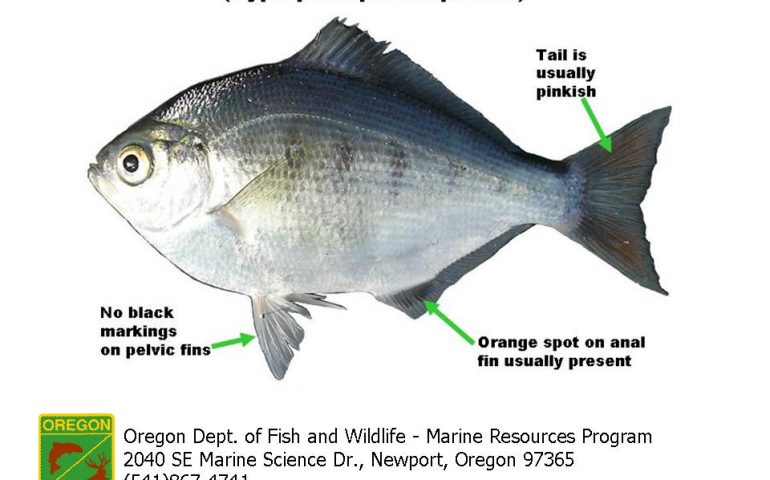Picture courtesy of Oregon Department of Fish and Wildlife
Surfperches: Family Embiotocidae
Species: Hyperprosopon ellipticum (Gibbons, 1854); from the Greek root words hyper (above) and prosopon (face, from the upward direction of the face), and the Latin word ellipticum (elliptical, referring to the outline of the body). Family Embiotocidae, subfamily Amphistichinae.
Alternate Names: Silver perch or surfperch. In Mexico called mojarra ovalada or perca.
Identification: Their coloring is silver with duskiness on the back and the tail is usually pink. They have no spots on the fins with the exception (generally) of a small orange spot on the anal fin. Often confused with walleye surfperch but the tips of the pelvic fins ARE NOT black and they do not have the large eyes like walleye surfperch.
Size: To 10.5 inches; those caught off piers are usually 6-8 inches.
Range: Rio San Vicente, northern Baja California, to Schooner Cove, near Ucluelet and Brooks Peninsula, Vancouver Island, British Columbia. Common from Santa Rosa Island, southern California, and central California, to Oregon. Uncommon along the mainland coast of southern California. I have only caught two silver surfperch from piers in SoCal, one at the Crystal Pier in San Diego and one at the Newport Pier. On the other hand I have caught them from virtually every oceanfront pier in central and northern California.
Habitat: Intertidal, shallow-water areas near both sand and rock. Common in both oceanfront areas and in bays. Recorded to a depth of 360 feet.
Piers: Most common on central and northern California piers. Best bets: Pismo Beach Pier, Seacliff State Park Pier, Santa Cruz Wharf, Pacifica Pier, Fort Point Pier, San Francisco Municipal Pier, Elephant Rock Pier, Fort Baker Pier, Point Arena Pier, Commercial Street Dock (Eureka), and the Trinidad Pier.
Shoreline: One of the main fish for sandy shore anglers in central and northern California anglers.
Boats: An inshore species rarely taken by boaters.
Bait and Tackle: Silver surfperch can be caught similarly to walleye surfperch with the following modifications: silver surfperch are usually mid-depth to the top of the water so fish off the bottom; and silver surfperch are more likely to take a worm-baited hook than walleye surfperch.
Food Value: Mild-flavored flesh with small flakes and a soft texture. The flesh is white colored and low in fat content. Can be cooked in any manner but most commonly fried. Many silvers are really too small to have much meat available but can be cooked whole.
Comments: Silver surfperch are very attractive perch that, in northern areas, seem to average much larger size than silver surfperch in the south. They are one of the main fish caught by pier anglers in central and northern California.

I’m wondering if the silver surfperch is edible. If so, does it have any nutritional value? Is there a recommended way to cook it?